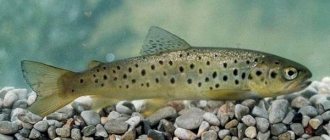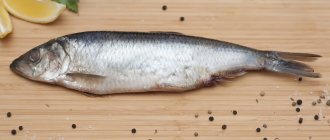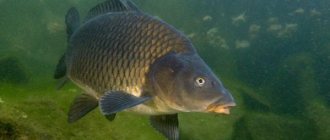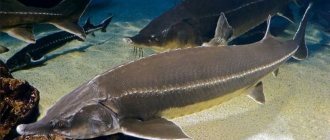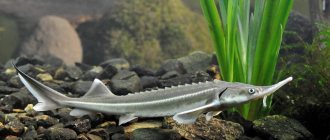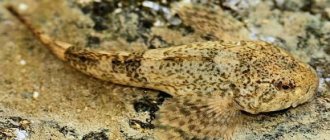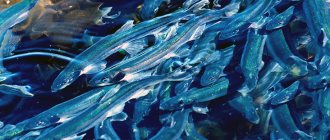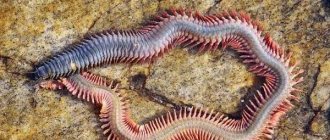Rainbow trout is the most popular of the vast salmon family. Due to its delicate taste and mass of useful properties, it is an object of serious fishing, bred in many artificial reservoirs. This is what we most often see on store shelves and on restaurant menus all over the world - dishes from it are prepared in Russia, Europe, the Americas, Asia and Africa.
Which fish is more suitable for baking, in your opinion?
- Salmon 48%, 720 votes
720 votes 48%720 votes - 48% of all votes
- Dorada 23%, 348 votes
348 votes 23%
348 votes - 23% of all votes
- Cod 14%, 212 votes
212 votes 14%
212 votes - 14% of all votes
- Perch 5%, 75 votes
75 votes 5%
75 votes - 5% of all votes
- Other 5%, 70 votes
70 votes 5%
70 votes - 5% of all votes
- Herring 4%, 53 votes
53 votes 4%
53 votes - 4% of all votes
- Haddock 2%, 30 votes
30 votes 2%
30 votes - 2% of all votes
Total votes: 1508
12.11.2019
×
You or from your IP have already voted.
Biological features
Elongated, fusiform body shape with 60-66 vertebrae, 3-4 spiny rays and 10-12 soft rays of the dorsal fin, 3-4 spiny rays and 8-12 soft rays of the anal fin, 19 soft rays of the caudal fin. An adipose fin is present, usually with a black edge. There are no nuptial tubercles (tubercles), but spawning males show slight changes in the head, mouth and coloration. The color of the back varies from blue to olive green. A pinkish stripe stretches along the lateral line. The ventral side is silver. The back, sides, head and fins are covered with small black spots. Coloring depends on the habitat, size and condition of the individual. River dwellers and spawning fish tend to be darker with more intense color, while lake dwellers are brighter and silverier. The absence of hyoid teeth is a feature by which rainbow trout can be easily distinguished from cutthroat trout.
Rainbow trout caught in Self Lake (Canterbury, New Zealand). From above, the individual acquired a spawning coloration. Below is a nondescript female. The fish have spots on their tails, while Brown Trout and Chinook salmon do not (fishingmag.co.nz)
Lifestyle
This fish chooses exceptionally clean habitats: fresh, cold springs with a transparent rocky bottom. Once a reservoir becomes polluted, trout are the first to die of all the underwater fauna. It follows that trout meat is environmentally friendly, and therefore healthy.
After spawning, the fish move down to the river beds and stay closer to the bottom. It feeds on minnows (small fish).
In summer, when the water warms up by more than 15°, schools stay at the mouths of rivers and springs, since the water temperature there is much lower.
Article on the topic: carp in September October in the Samara region
Individuals that have not reached half a kilo in weight are not predators and parasitize at the expense of their older relatives, feeding on their eggs. In addition, they feed on earthworms, which are washed out of the soil with rain.
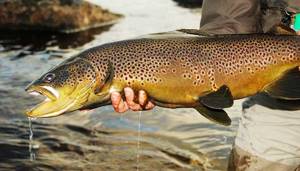
Habitats and biology
Rainbow trout are hardy fish that breed easily, grow quickly, and are tolerant of a wide range of environmental conditions and handling. Grown-up fry, which usually feed on zooplankton, can be easily tamed to artificial feeding. Easily adapts to a variety of habitats, ranging from anadromous life (a variation known as steelhead, which lives in the ocean, spawning in fast-flowing, oxygen-rich rivers with a rocky bottom) to permanent residence in lakes. The anadromous variation is famous for its rapid growth. It reaches 7-10 kg in 3 years, while the freshwater variation reaches only 4.5 kg over a similar period of time. The species adapts to wide temperature ranges (0-27°C), but spawning and growth occur in a narrower range (9-14°C). The optimal water temperature for rainbow trout is below 21°C. Water temperature and amount of food affect growth and development, so the rate of maturation varies, but is usually 3-4 years.
Females produce up to 2,000 eggs per kg of body weight. The caviar has a relatively large diameter (3-7 mm). Most fish spawn once in the spring (January to May), but through breeding and increasing daylight hours, hatchery variations have been developed that mature earlier and spawn year-round. Crossbreeding also achieves excellent breeding characteristics, increasing growth rates, disease resistance and fertility, as well as improving the quality and taste of meat. Genetic manipulation of the sex chromosomes of embryos has produced sterile triploid females that lack the hook-shaped jaw that customers don't like, and ensures that escaped specimens that end up in the wild cannot reproduce.
In culture systems, trout will not reproduce naturally. Therefore, fry are obtained through artificial reproduction or collection of eggs in natural habitats and subsequent cultivation in an incubator.
The fry develop well in incubators. Wild adult trout feed on aquatic and terrestrial insects, mollusks, crustaceans, fish, caviar, gudgeon, and other fish; but the most important food is freshwater shrimp, which contain carotenoid pigments responsible for the orange-pink color of the meat. In aquaculture, synthetic pigments astaxanthin and canthaxanthin are added to the feed to obtain the desired color.
Types and subspecies of trout
Types are divided into:
- Salmo - these include subspecies: Adriatic, Sevan, Amu Darya, Turkish flathead, brown trout (also has several subspecies), marbled, summer trout;
- Oncorhynchus - these include Arizona, golden, biwa trout, Clark's salmon, Mikizha;
- Salvelinus – this species includes American palia, big-headed loach, Dolly Varden, Lake cristome loach, silver loach.
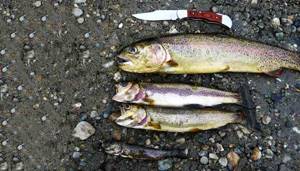
Production
Rainbow trout production cycle
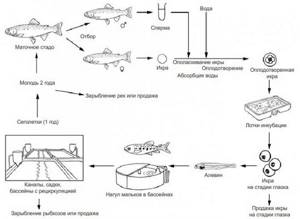
Rainbow trout production cycle
Production systems
Monoculture is the most common practice for raising rainbow trout. Intensive cultivation systems are suitable in most cases and make production economically viable.
A potential site for commercial trout production must be supplied year-round with high-quality water (without aeration - 1 l/min per 1 kg of trout, or 5 l/sec per ton of trout with aeration), which must meet a number of criteria:
| Dissolved O2: | at the saturation limit |
| CO2: | <2.0 mg/l. |
| Temperature: | 12-21ºC. |
| pH: | 6,5-8,5. |
| Alkalinity (CaCO3): | 10-400 mg/l. |
| Manganese: | <0.01 mg/l. |
| Iron: | <1.0 mg/l. |
| Zinc: | <0.05 mg/l. |
| Copper: | <0.006 mg/l in soft water or <0.3 mg/l in hard water. |
Where pumping is not required, groundwater may be used, but in some cases aeration may be required. Supersaturated river water with dissolved nitrogen can cause gas bubbles to appear in the blood of fish, which interfere with blood circulation; a condition known as gas bubble disease. River water can be used, but fluctuations in temperature and water flow may alter production performance. If river water meets the necessary requirements, then trout are usually raised in canals or ponds equipped with running water, or in cages and RAS.
Fish seed material
Broodstock development
Aquacultured trout do not reproduce naturally, so eggs are obtained through the artificially induced spawning of mature females from the broodstock. Although two-year-old trout can already spawn, females are rarely used for breeding before they are three or four years old. The number of broodstock individuals depends on the number of fry required for production on the farm. It can be calculated based on the survival rate at different life stages and the fertility of the broodstock females. As a rule, one male is enough for three females of the broodstock. Males and females are usually kept separately. Broodstock maintenance is expensive and labor-intensive, so some farms purchase eye-stage eggs from third-party producers; the latter must have certificates of freedom from disease, otherwise they are treated with iodine (100 mg/liter for 10 minutes) and the water temperature is gradually increased to the temperature of the incubator. Broodstock are selected for rapid growth and early maturation (usually after 2 years). One commonly used method is to use an all-female sex-reversed broodstock to produce all-female offspring that grow faster. Functional males are produced at the fry stage by oral administration of 17-methyltestosterone. This male hormone is introduced into the food.
Collection and fertilization
The process and technique of raising rainbow trout is well studied and developed. The most common is the dry method of egg fertilization. Eggs from females are removed manually (under anesthesia) by applying pressure from the pelvic fins to the anus or by air spawning, which causes less stress on the fish and produces cleaner, healthier eggs. Air is injected with a hypodermic needle (about 10 mm) under pressure (2 psi) into the body cavity near the ventral fins and thus expels the eggs. Air is removed from the body cavity by massaging the sides of the fish. Up to 2,000 eggs per kilogram of body weight are collected in a dry pan and kept dry for better fertilization.
The semen of males is collected in the same way as that of females, in a bowl, avoiding contact with water and urine. Semen from several individuals (for better fertilization, they are taken not from one, but from several males) is mixed with caviar. To reduce the likelihood of inbreeding, it is recommended to mix the reproductive products of three or four males before fertilization. Water is added to activate the sperm and increase the volume of the eggs by about 20%, filling the perivitelline space between the shell and the yolk. This process is known as "water curing".

Rainbow trout caviar at the eye stage (ikra-dabie.pl)
After fertilization of trout eggs and washing (de-sticking), an active process of crushing and compacting the shell occurs. Fish farmers call this period “spawn swelling.” The eggs lie in running water for at least 6 hours after fertilization, in the dark and with water changes.
Eggs can be transported 6-12 hours after fertilization, for 3 days, then only at the eye stage. At the “eye” stage, or stage of eye pigmentation, the eggs are resistant to mechanical stress.
To increase productivity, a technique has been developed that uses the culture of unisexual females or triploids. Triploidy is induced by pressure or heating of the eggs. Same-sex individuals are obtained by fertilizing normal female eggs (XX chromosomes) with the sperm of masculinized females with a sex change (XXX chromosomes). Mature testes of sex-changed individuals are large and round, but do not have an exit hole. Therefore, the testes are removed from the abdominal cavity and torn to drain the milk into a container. An equal volume of swelling fluid is added to make the sperm motile and ready to fertilize normal eggs. One of the advantages of this method is that only the broodstock consists of sexed individuals and these can be reared separately, while the fish sold are not treated with hormones.
Incubation
The eggs in the incubator are not disturbed until the eye stage is reached. They can be in setter trays, vertical flow incubators or setter tanks. The trays are usually 40-50 cm wide, 20 cm deep and up to 4 m long. They contain 2 rows of eggs placed in wire baskets or screened trays, fixed 5 cm above the bottom, where water passes through the tray (3-4 l/min). As they hatch (4-14 weeks), the fry fall through the net into the bottom chute. An alternative to such trays are vertical incubators, in which up to 16 trays are stacked on top of each other. Water flows from one source (3-4 l/min) through the eggs, flows from above and pours into the pan. This aerates the water, allowing large quantities of eggs to be incubated in a minimum amount of space. The prelarvae may remain in the trays until they begin to swim, approximately 10 to 14 days after hatching.
The time taken to hatch varies depending on water temperature, taking 100 days at 3.9°C and 21 days at 14.4°C (about 370 degree days). In incubator vessels (Weiss apparatus), commercially available or made independently from a 40-liter drum and PVC pipe, water enters from the bottom and flows upward. In such a flow of water, without large financial costs, it is possible to mix up to 50,000 thousand eggs and keep them suspended. A necessary condition for proper operation is filling the vessel no more than 2/3 with eggs and raising the eggs when stirring to no more than 50% of their height in a static state.
In all the above methods, dead eggs are removed regularly to prevent fungal infection. Prevention of fungal infection is carried out with formaldehyde (37% formaldehyde solution). It is added to the supply water in a ratio of 1:600 for 15 minutes daily, but not within 24 hours after hatching. Once the eye stage is reached, weak and undeveloped eggs are removed.
As a rule, hatching reaches 95% of the total number of eggs. Rainbow trout larvae and fry have a supply of nutrients in the yolk sac, which lasts for 2-4 weeks. Hatching of one batch usually takes 2-3 days, during which time the shells of the eggs, as well as dead and deformed fry, are regularly removed. The eggs are incubated separately from the hatching trays and transferred to them after hatching. After hatching, the trays are removed from the tray, while the depth remains shallow (8-10 cm), and the strength of the water flow is reduced until the fry reach the active swimming stage, absorb the yolk sac and begin to actively search for food.
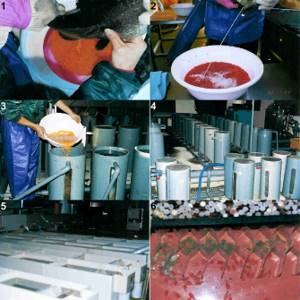
1. Expressing the female’s eggs; adding sperm to caviar. 2. The fertilization rate can be increased by mixing a saline solution (NaCl 90.4g, CaCl2 2H2O 3.4g, KCl 2.4g per 10 liters of water). 3. Placement of fertilized eggs in incubators. 4. This type of incubator is traditionally used in South Korea. 5. This type of growing system is traditionally used in South Korea. The optimal water temperature for incubating fertilized eggs is 10 degrees, at which the eggs mature to the eye stage on the 16th day, the larvae appear by the 32nd day and begin to swim by the 60th day. During incubation, physical impact and light exposure to the eggs should be avoided. 6. Rainbow trout larvae have just hatched. To prevent infection, 100 ppm formaldehyde is added to the water. Dead eggs are regularly removed (www.lib.noaa.gov/retiredsites/korea/main_species/rainbow.htm)
Feeding the fry
Trout fry are traditionally raised in fiberglass or concrete tanks, preferably round in shape, which ensures even flow and distribution of the fry, but square tanks are also available. Pools usually have a diameter of 2 m or, if it is a square, 2x2 m with a depth of 50-60 cm. Water is supplied using an elbow pipe or a sprayer, which circulates the water. The drain, protected by a strainer, is located in the center of the tank. This position ensures that the water forms a whirlpool so that the waste is concentrated in the center and can be easily removed. The sump or drain pipe, which is used to regulate the water level, is connected to an elbow pipe on the side of the tank.
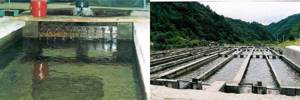
Indoor culture of Rainbow Trout fry (left). Traditional trout culture channels in South Korea (right) (www.lib.noaa.gov/retiredsites/korea/main_species/rainbow.htm)
Rainbow trout fry are fed special juvenile feed starting when approximately 50 percent have reached the active swimming stage. Use automatic feeders. When most of the fish begin to feed actively, feed should be fed daily at a rate of 10% of the fish's weight for 2-3 weeks, preferably continuously, using a clock feed mechanism. Pelleted feed made from a mixture of fishmeal (80%), fish oil and grain provides balanced nutrition, promotes growth and product quality. They contain approximately 50% protein, 12-15% fat, vitamins (A, D and E), minerals (calcium, phosphorus and sodium) and pigment to produce pink meat (if necessary).
High-energy commercial feeds and proper feeding regimens provide a feed conversion ratio of 0.8:1. When the fry reach 15-25 mm, feeding is carried out according to tables that are based on data on the temperature and size of the fish. Automatic feeders are convenient, but in the early stages it is better to feed by hand to avoid overfeeding. Automatic feeders are more effective for larger fish. During the process of growing trout, the content of dissolved oxygen is controlled. To reduce density, fish are moved to larger tanks.
Rainbow trout feeding methods

When the fry reach 8-10 cm in length (250 fish/kg), they are transferred to reservoirs for feeding in the open air. These can be concrete channels, flowing Danish ponds or cages. Individual canals and ponds are usually 2-3 m wide, 12-30 m long and 1-1.2 m deep. The canals supply oxygenated water. Oxygen concentration can be increased by increasing the speed of water flow; however, trout are vulnerable to the quality of incoming water, and environmental temperature has a significant impact on their growth rate. The number of channels or ponds in rows varies depending on pH (a low pH of 6.5-7.0 reduces the concentration of non-ionized ammonia) and the slope of the ground (aeration requires a 40 cm drop in ground level between channels). In terms of hygiene, water quality and disease control, a parallel design is preferable since any contamination flows through a small part of the system. In both systems, fry are stocked at 25-50 fry/m², which should provide up to 30kg/m² of adult trout with proper feeding and water supply, although higher production is possible.
Rainbow trout fingerlings
Rainbow trout usually grow to market size (30-40 cm) in 9 months, although some fish take more than 20 months to grow to a large size. Individuals are usually sorted 4 times (2-5 g, 10-20 g, 50-60 g and more than 100 g) in the first year of production. During this period, it is necessary to reduce density to ensure faster growth, adjusting the feed supply to obtain the same size of individuals. Assessing the number and size of individuals (twice a month) allows you to answer important management questions: assess and calculate growth rates, feed transfer, production costs and proximity to maximum load.
Alternative nursery systems for rainbow trout include cage systems (6 x 6 m to a depth of 4-5 m) in which fish (up to 100,000 fish) are kept in floating cages in freshwater and marine environments that provide a good water supply and sufficient dissolved oxygen. This method is technically simple as it involves natural bodies of water at lower capital costs, as opposed to using flow-through systems. However, here the fish are vulnerable to predators (rats and birds), to water quality, and growth rates depend on the ambient temperature. In such systems, high stocking densities are achieved (30-40 kg/m²), and fish transferred to sea cages have higher growth rates and larger sizes. In less than 18 months, fry weighing about 70 g reach 3 kilograms.
The benefits of rainbow trout for the body
The American Heart Association recommends eating 85-gram servings of cooked fish at least twice a week. Rainbow trout is one of the healthiest fish. You can maximize the health benefits of eating rainbow trout by using various cooking methods, such as steaming, grilling, or baking. Here are some of the main beneficial properties of trout:
Excellent source of high quality protein
If you're looking for a new food (beyond chicken, beef and pork) that can increase your body's protein intake, rainbow trout may be your new source of this important nutrient. 100 grams of cooked wild rainbow trout contains 22.9 grams of protein. The Institute of Medicine recommends getting 10 to 35 percent of your total calories from protein. This means that if your goal is to consume 1,800 calories per day, between 180 and 630 of those calories should come from protein. According to the FDA, every gram of protein has 4 calories. Men need about 56 grams of protein per day, and women need about 46 grams of protein.
Protein intake is vital for your body to function properly. It is an extremely important building material for muscles, skin, hair, nails, blood and cartilage tissue. Most enzymes that help your body function normally are made of protein.
Excellent source of omega-3 fatty acids
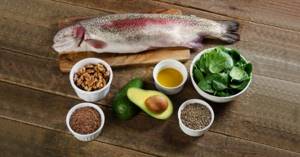
Many would-be nutritionists recommend that people stay away from any fat. Either way, if you're trying to lose weight or gain weight, you need to consume fat. However, not all fats are created equal. You should stay away from some fats (trans fats and excess saturated fats) and opt for others (monounsaturated fats, polyunsaturated fats).
Some of the healthiest fats are omega-3 fatty acids. The ratio between omega-6 fatty acids and omega-3 fatty acids is important for the health of the body, since most people's normal diet consists primarily of foods rich in omega-6 fatty acids. These fatty acids are mostly not produced in our bodies. Therefore, you need to eat foods like rainbow trout as they contain high amounts of this nutrient.
A cooked 100 gram serving of farmed rainbow trout contains 1,236 mg of omega-3 fatty acids (2): eicosapentaenoic acid (EPA) and docosahexaenoic acid (DHA) (found in fatty fish and algae). This is much higher than the World Health Organization's recommended amount of 250-500 milligrams per day. Additionally, the same serving contains 949 mg of omega-6 fatty acids.
Rainbow trout can help balance the ratio of omega-6 to omega-3, which should ideally be 1:1 or at least 2:1. A balanced ratio may help reduce the risk of heart attacks, cardiovascular disease, depression, anxiety, breast cancer, prostate cancer and colon cancer.
Rich in potassium
Potassium is one of the most underrated minerals. Many people believe that if they simply reduce their salt intake, their risk of high blood pressure will decrease. It is not true. Your body balances this salt level by looking at your potassium to sodium ratio.
According to the U.S. Centers for Disease Control and Prevention, adults over the age of 19, teens ages 14 to 18, and pregnant women should consume 4,700 milligrams of potassium daily and no more than 2,300 milligrams of sodium per day. Rainbow trout contains 481 mg of potassium and 31 mg of sodium.
A potassium-rich diet not only helps manage high blood pressure, but also helps relieve stroke, kidney disease, anxiety and stress. Potassium also increases muscle strength, metabolism, and improves nerve function.
Good source of phosphorus
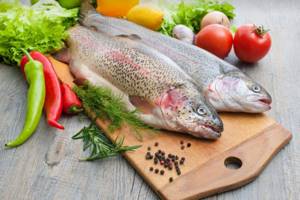
Phosphorus is the second most abundant mineral in the body, after calcium. Phosphorus and calcium often work together to maintain the integrity of bones and teeth, which is why 85% of the phosphorus in the body is found in bones and teeth. A phosphorus-rich diet also helps improve digestive tract function by stimulating digestion with riboflavin and niacin, and helping with the proper elimination of waste products while keeping the kidneys healthy. In addition, phosphorus is essential for the growth, maintenance and repair of all body tissues as they are required for the genetic building blocks, DNA and RNA.
Most people have enough phosphorus in their diets. According to the Institute of Medicine, adults are recommended to consume 700 mg of phosphorus per day. Children and adolescents aged nine to eighteen years are recommended to consume 1,250 mg of phosphorus per day. 100 g of rainbow trout contains 271 mg of phosphorus, which is on average 27% of the RDI.
Excellent source of B vitamins
Thiamine, niacin, vitamin B6, vitamin B12 and pantothenic acid are classified as B vitamins. Water-soluble vitamins play an important role in cellular metabolism. Thiamine helps in breaking down sugars and amino acids, making them bioavailable. Niacin helps the body convert carbohydrates, fats and proteins into energy. Niacin also plays a role in removing harmful chemicals from the liver and promotes the production of various sex and stress hormones in the adrenal glands.
Vitamin B6 helps the body produce several chemicals that help one brain cell communicate with another brain cell, called neurotransmitters. Neurotransmitters such as serotonin and norepinephrine can also affect your mood and the body's internal circadian rhythm.
Good Source of Selenium
Selenium is an essential mineral for normal brain function, a healthy immune system, and the reproductive system of both men and women. When combined with vitamin E, selenium can act as an antioxidant and may reduce the risk of cancer and prevent sunburn. The most common source of selenium is mushrooms (as selenium is found in soil), but rainbow trout also contain significant amounts of this mineral.
Children over 13 years of age and adults should consume 55 mcg of selenium (pregnant women 70 mcg) per day. 100 grams of rainbow trout contain 12.6 mcg of selenium or 23% of the RDA (18% for pregnant women).
Low pollutant content
According to the Environmental Defense Fund, farmed rainbow trout are low in mercury and polychlorinated biphenyls (PCBs). Fish that have high levels of mercury or PCBs can cause side effects such as kidney damage, mental disorders, brain damage and fatigue, especially in children and fetuses. Seafood Watch recommends avoiding wild rainbow trout due to the increased risk of contamination.
Providing feed
Rainbow trout feeds have been modified over the years, and extrusion technology has produced compact pelleted feeds for all developmental stages. Granules obtained in this way adsorb a larger amount of introduced fish oil and make it possible to obtain high-energy feed with a fat content of more than 16%. The level of dietary protein in high-energy feeds has increased from 35% to 45%, and the level of fat exceeds 22%. Rainbow trout feed formulations contain fishmeal, fish oil, grains and other ingredients. Due to the use of alternative protein sources such as soybean meal, the fishmeal content of pellets has dropped to less than 50% in recent years. Rainbow trout efficiently digest these high-energy feeds, and feed conversion ratios often approach 1:1.
Feeding methods vary among production systems. Hand feeding is suitable for small fish that eat fine food. Mechanical feeders, which are powered by electricity or solar power, are often used to deliver specified amounts of feed at specific intervals depending on the size of the fish, temperature and time of year. Automatic feeders can be used for fish larger than 12 cm.
Fishing methods
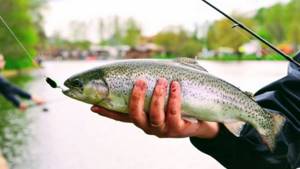
Trout is a fairly versatile fish that can be caught in a variety of ways:
- feeder;
- fishing rod;
- fly fishing;
- spinning rod
All types of fishing, with the proper approach, are effective and allow you not only to catch fish, but also to fully enjoy the process of hunting trout.
Fly fishing and spinning
These two types of fishing are the most sporting, involving constant movement around the water area, selection of baits and methods of presenting them. For rainbow trout, light tackle is used, which allows the use of miniature wobblers and spoons, as well as weightless flies.
In ultralight there are entire trout directions:
- Catching rainbow brook mykiss. Hunting is carried out for wild varieties of trout in mountain streams, fast northern rivers and other bodies of water where this fish lives.
- Fishing on paid lakes and ponds. The classic domesticated form of trout is mainly caught here.
There are increased requirements for spinning gear for trout fishing. They should simultaneously allow you to work with weightless baits and catch powerful, sharp fish.
The invisibility of the gear also comes to the fore, so the use of the thinnest cords and monofilament lines is important. This means using high-quality reels with sensitive friction and soft fishing rods that effectively dampen fish jerks.
Advice! Everything said above is also true for fly fishing.
Donka and float rod
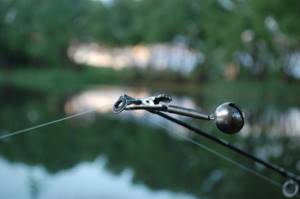
These methods are mainly used on paysites. Since they are not as dynamic as spinning and fly fishing, they are used more often by beginners who, in addition to spending time on the pond, also want to catch fish.
There is nothing special about the gear. If possible, you should use thinner equipment that does not alarm the fish. Of the baits, preference is given to the following:
- trout paste;
- shrimp or crayfish meat;
- red worm;
- insect larvae.
It is advisable to fish with bottom gear at long distances, but float gear is effective for short-range fishing.
Lures for rainbow trout
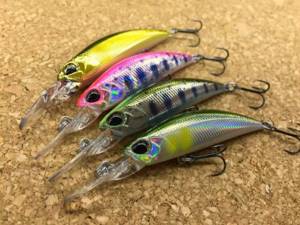
Considering the omnivorous nature of trout, it can be caught using a wide variety of baits of artificial and natural origin. Fish preferences change depending on the time of year, water temperature and other natural factors.
The following baits are used in trout spinning:
- Microoscillators. Today the most popular baits, especially on cultivated reservoirs.
- "Silicone". Passive “rubber” of small size is more often used. Relevant when fish feed at the bottom.
- Wobblers. Universal baits that work both in rivers and in closed reservoirs.
- Rotating spinners. Today they are rarely used and only by beginners.
The following nozzles and baits are used in the bottom and float directions:
- earthworm;
- bloodworm;
- larvae of semi-aquatic insects;
- trout paste;
- canned corn;
- shrimp and other small crustaceans;
- maggot;
- caddisfly
There are more specific baits, but they are in demand in rare cases on individual bodies of water. They are used by experienced fishermen who have well studied the habits of local trout.
Handling and processing
To replenish the broodstock, the fish are carefully examined, the quality of the fins, size and the presence of any external signs of disease are assessed. Then they are placed in special ponds for transportation. Food fish are humanely killed after similar but less stringent inspections. All fish must fast for 3 days before slaughter. After slaughter, the head is left behind, so headless fish spoil faster. Rainbow trout is marketed fresh and frozen. The shelf life in ice is 10-14 days. Trout is sold whole, gutted, as fillets (usually boneless), or as a value-added product such as smoked trout.
How are trout bred?
Considering where trout are found in Russia, you can understand why the popularity of commercial fishing is growing. In many regions of our country, the fish presented are not found in local reservoirs. To be able to catch trout without traveling far from home, artificial reservoirs are created.
Rainbow trout are almost always bred here. Its meat is very tasty and tender, and brings great benefits to the human body. Small fish are first bred in special cages. When individuals reach medium size, they are planted in ponds and lakes.
In such reservoirs, trout are caught by both amateur fishermen and fishing enterprises. The former can pay for a certain amount of time to stay on the pond and fish a certain amount of fish out of the water with their own hands. On an industrial scale, fishing is carried out to supply fresh trout to store shelves in the nearest regions.
Production costs
Like any other business, rainbow trout farms strive to increase revenue and reduce costs. They resort to the optimal ratio of price and quality of feed and materials, and an effective feed conversion ratio. The average cost of production is from 1.20 to 2.00 US$ per kilogram. Production costs include the purchase of fry 6-8 cm long, starting at US$100 per 1,000 pieces. Subsequent feeding costs for one year will be US$1,000-$1,400. Veterinary and drug costs range from US$50 per ton, with transportation and sales fees reaching US$500 per ton.
What to do with trout caviar
The eggs of any type of trout are small, about 3 mm, and have a characteristic dark orange hue. Experienced housewives know how to properly salt caviar. It is better to salt caviar with added sugar. Home-salted caviar tastes better, but has a shorter shelf life, so it is better to store it in the freezer. This will not change the taste and quality of the product.

Diseases and measures to combat them
There are many diseases and parasites that harm rainbow trout, some of which are listed in the table below. Prevention is the primary control measure. The risk of pathogens is reduced by thoroughly disinfecting the incubator with limited access, installing disinfecting baths and disinfecting equipment.
In some cases, antibiotics and other pharmaceuticals are used for treatment, but their presence in this table does not imply a recommendation by the World Food Organization.
| Disease | Pathogen | Exciter type | Symptoms | Treatment |
| Furunculosis | Aeromonas salmonicida | Bacterium | Intestinal inflammation; redness of the fins; boils on the body; damage to pectoral fins; tissue death | Add an antibiotic, such as oxytetracycline, to the feed |
| Similar to furunculosis | Aeromonas liquefaciens | Bacterium | Smaller lesions on the body that become open wounds; reddening of fins and tissue destruction | Same as with furunculosis |
| Vibriosis | Vibrio anguillarum | Bacterium | Loss of appetite; redness of the fins and the area around the anus and mouth; sometimes bleeding around the mouth and gills; potentially high mortality | Same as for furunculosis, additional vaccination |
| Kidney disease | Corynebacterium | Bacterium | Whitish lesions in the kidneys; bleeding from the kidneys and liver; some fish may lose their appetite and swim close to the surface; the color of the cover darkens | Same as with furunculosis |
| Bacterial gill disease | Myxobacterium | Bacterium | Loss of appetite; swelling and redness of the gills; in the final stage, the gill filaments gather together and become pale, mucus is secreted, which blocks the functioning of the gills | Bathing in a bactericidal solution and regularly filtering water |
| Infectious pancreatic necrosis | IPN | Virus | Restless, chaotic swimming, eventually to the bottom of the tank, where the fish dies | Cannot be treated; removal of infected individuals |
| Infectious necrosis of hematopoietic tissue | INGTL | Virus | Chaotic swimming ends up floating belly up, breathing rapidly, followed by death; eyes bulge; bleeding from the base of the pectoral fins, dorsal fin and anus | See previous paragraph |
| Viral hemorrhagic septicemia | HCV | Virus | Protruding eyes, in some cases bleeding eyes; pale gills; abdominal swelling; lethargy | See previous paragraph |
| Ichthyophthiriasis (white spot, semolina) | Ichthyophthirius multifilis | Protozoa | White spots on the body; lethargy; the fish tries to remove parasites by rubbing against the walls of the tank | Bathing in formaldehyde to remove surface parasites; copper sulfate for parasites under the scales; prevention - fast flowing water |
| Myxosomiasis (whirling disease) | Myxosoma cerebralis | Protozoa | Darkening of the skin; spiral swimming; deformations around the gills and caudal fin; ultimately fatal | There is no treatment; fish must be removed from contaminated water; water is treated with calcium cyanomide |
| Octomitosis | Hexamita truttae | Protozoa | Lethargy, sink to the bottom of the tank, where they die; some fish make sudden random movements | Add calomel to the feed |
| Costiosis | Costia necatrix | Protozoa | Blue-gray mucus on the skin that contains parasites | Formaldehyde baths |
| Trematodosis | Gyrodactylus sp. | Fluke | Parasites attach to the caudal and anal fins; the body and fins are destroyed, leaving lesions that are attacked by Saprolegnia | Formaldehyde baths |
| Diplostomiasis | Diplostomum spathaceum | Fluke | Clouding of the lens of the eye, deformation | There is no treatment; exclude entry of gastropod vectors |
Statistics
World production of rainbow trout
Rainbow trout production has grown exponentially since the 1950s, especially in Europe and more recently in Chile. This is primarily due to the growth of inland aquaculture and domestic market satisfaction in France, Italy, Denmark, Germany and Spain, and the development of marine aquaculture and exports in Norway and Chile. Currently, Chile is the largest producer. Other major producing countries are Norway, France, Italy, Spain, Denmark, USA, Germany, Iran and the UK.
Market and trade
The objectives of rainbow trout aquaculture are broad. It provides the market with food products, live fish for replenishing rivers and lakes, recreational hunting (especially important in the USA, Europe and Japan), as well as planting material, eggs and juveniles for sale to other farms.
Trout food products are supplied fresh and smoked, whole and as fillets, canned and frozen. Trout can be steamed, fried, boiled, microwaved, or baked. Waste from processing is used to produce fishmeal or as fertilizer. The market for fresh fish is large. Trout meat is juicy and tender, white to pink in color with a mild flavor. The fish reaches commercial size by 9 months, but reaches “pan size”, 280-400 g, after 12-18 months. The optimal size before harvest varies depending on the region of sale: in the USA, trout are harvested at a weight of 450-600 g; in Europe - 1-2 kg; in Canada, Chile, Norway, Sweden and Finland - 3-5 kg (from sea cages). Meat color preferences are also changing around the world, with the United States favoring white meat and Europe and other parts of the world favoring pink meat resulting from pigment additives in aquafeed.
Strict food safety regulations and guidelines are applied to regulate the production of rainbow trout.
Maintaining hygiene during the production process and safe transportation of fresh fish are of paramount importance to ensure product quality meets food agency guidelines.
Status and development trends
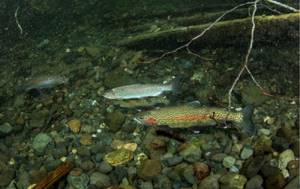
Rainbow trout aquaculture has been developing over several hundred years. Thanks to well-proven techniques, many aspects of the industry demonstrate high efficiency. However, ongoing research and development efforts aim to improve production and sales efficiency by increasing planting densities, improving recycling technology, developing genetically improved breeds for rapid growth, controlling maturation and sex, improving nutrition, reducing effluent phosphorus concentrations, and developing marketing. One of the new methods of reducing production costs is the use of genetically modified hormone. However, public opinion towards genetically modified foods remains negative, so there may be problems with the use of this method. As production continues to increase, research is needed to minimize costs and develop the industry.
Royal trout
- Cooking time: 40 minutes.
- Number of servings: 4 persons.
- Calorie content: 296 kcal/100 g.
- Purpose: for lunch.
- Cuisine: Russian.
- Difficulty of preparation: medium.
To surprise guests with a delicious dish, the fish can be stuffed with zucchini, carrots and shrimp. For the filling, cut the vegetables into small strips, fry, add shrimp, cream and simmer for 10 minutes. However, the royal recipe for salmon baked with cherries and cheese will be much more luxurious. It will surprise you with its culinary delights and delicious combination of original ingredients. When baking, you can use cranberries instead of lemon.
Ingredients:
- Freshwater salmon – 500 g;
- Cherry – ½ tbsp;
- Hard cheese – 150 g;
- Onion – 1 pc.;
- Lemon – 1 pc.;
- Mayonnaise – 100 g;
- Salt - to taste;
- Rosemary – 1 bunch.
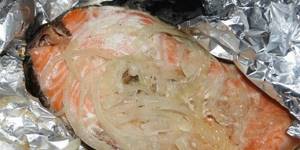
Cooking method:
- Peel and bone live fish, cut into steaks and add salt.
- For the sauce, mix chopped cherries with mayonnaise, maintaining a 1:1 ratio.
- Marinate in the sauce and leave for 30 minutes.
- Place the fish skin, scales down, on the foil. Spread the onion bed and salmon steaks over the skin.
- Grate the cheese on top and garnish with lemon slices.
- Cover with foil and bake for 40 minutes at 180°C.

